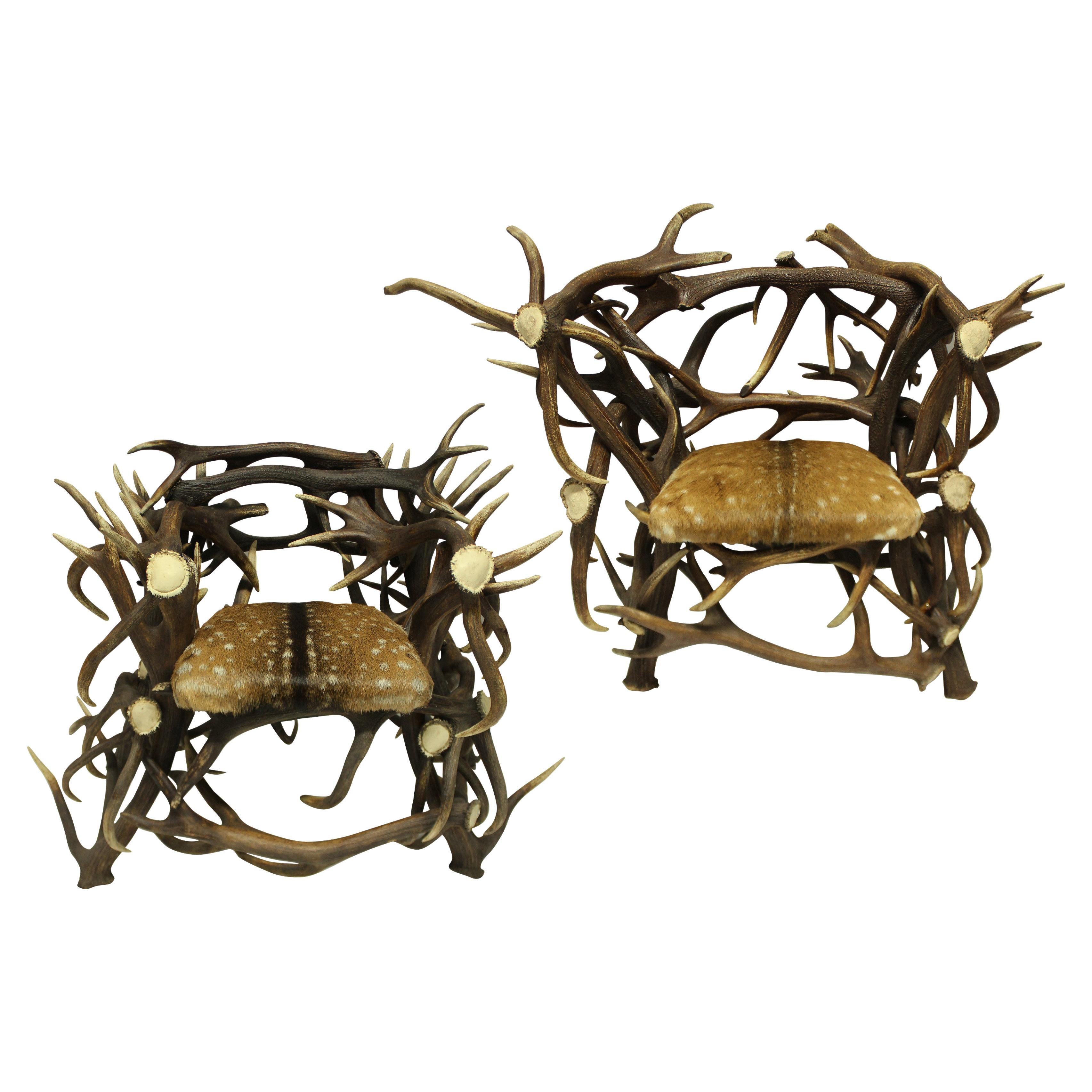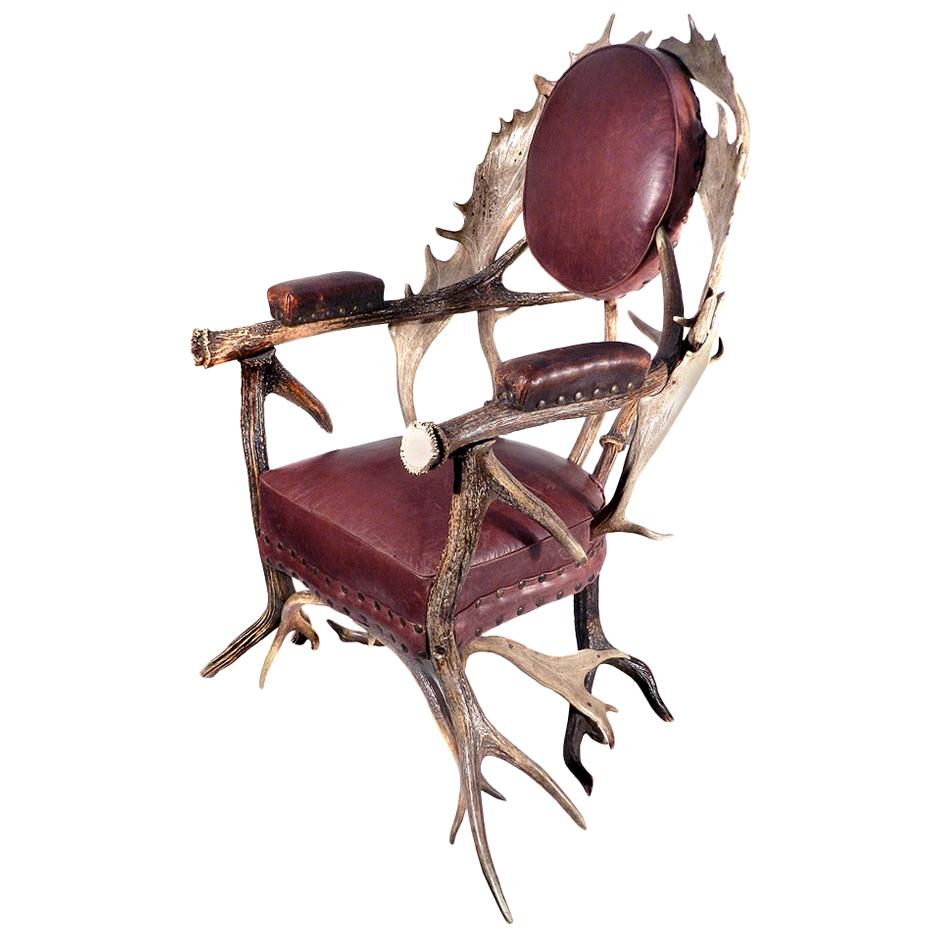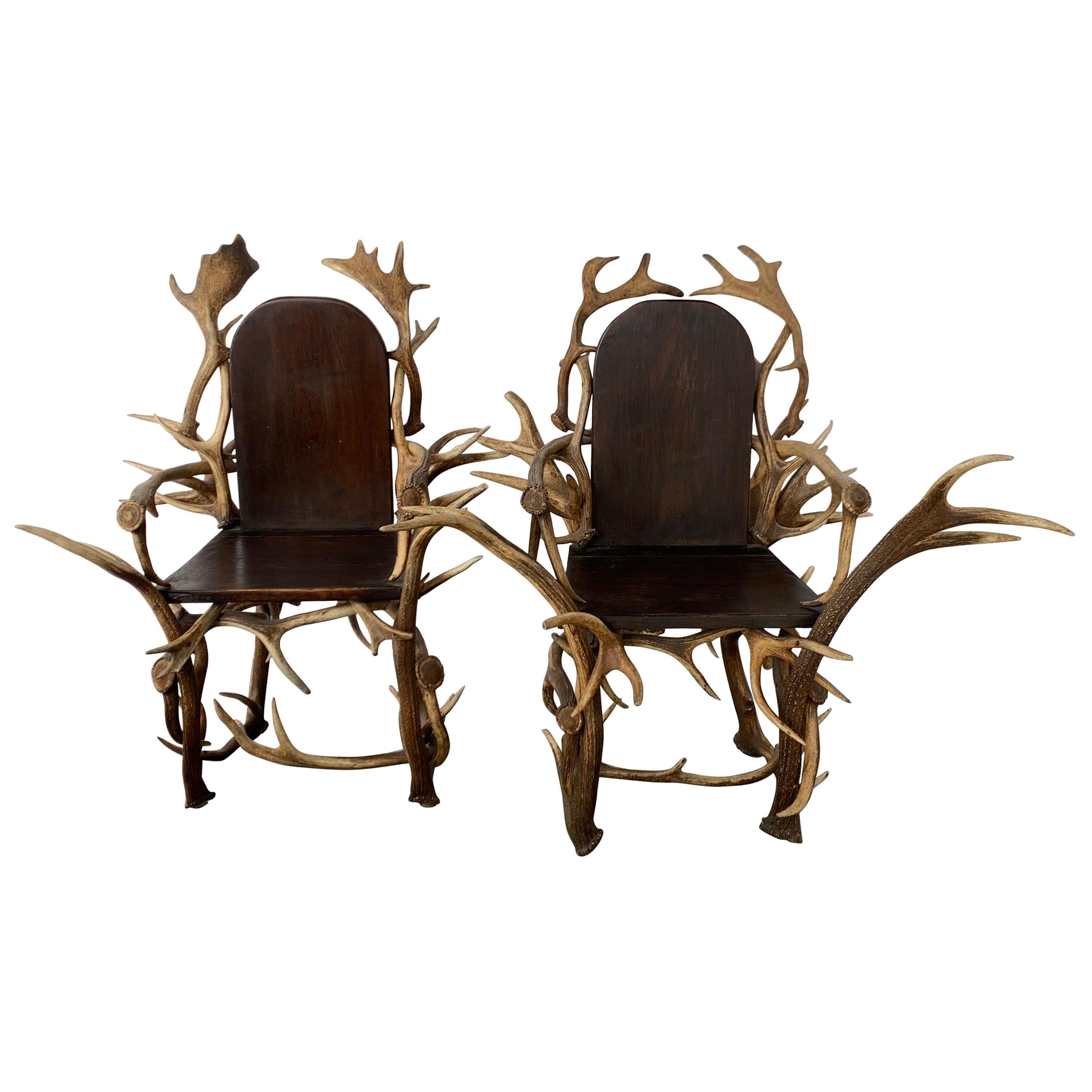Items Similar to Armchair, Pair, Hunting Trophy, Antler, Red Deer, Fallow, Wild Boar, Hide
Want more images or videos?
Request additional images or videos from the seller
1 of 8
Armchair, Pair, Hunting Trophy, Antler, Red Deer, Fallow, Wild Boar, Hide
About the Item
Pairs of hunting trophy armchairs are exceptionally rare. This pair are also unusual because they are made from a few large antlers giving them a minimalist quality. The fluid form of the antlers creates a sculptural, organic aesthetic. They are also usable and very comfortable. It has taken great skill to make these chairs, selecting massive antlers to create exquisite form and stability within a minimalistic, sculptural aesthetic. They are dramatic and unusual injecting a naturalistic and organic gravitas to any interior which reflects the grace, agility and presence of the kings of forest that they came from.
The impressive crestings, sides and front stretchers on each armchair are made from five magnificent fallow deer antlers. The arms and supports on each chair are made from eight massive red deer antlers. The antlers are arranged creatively to create both, a stable structure and sculptural form. The seats are upholstered in wild boar hide.
Dimensions: Width 91cm., 35.83in., Height 132cm., 51.97in., Depth 96cm., 37.80in.
Museums With Collections Of Antler Furniture
• Victoria & Albert Museum, London
• Museum casle trautenfels, Trautenfels – Austria
• Museum of natural history, Venice
• Palace Museum, Beijing
“There is grace and movement in the antler itself. They’re one of the most beautiful forms in nature…” Gail Flynn
Hunting trophies have been used as source material for clothes hooks, storage racks and lamps since the 15th century. Mounting antlers and stuffed heads on walls provided impressive, decorative displays for hunting trophies. A hunting lodge replete with antlers and stuffed animals was most likely where ideas for antler furnishings emerged.
At the beginning of the 19th century antler furniture was made exclusively for the European nobility to decorate palaces, castles and country seats. The furniture was either made completely from stag antler, or it was decorated with antler pieces from the stag, deer, fallow deer and others, or veneered with sliced antler pieces to create a hunting design.
The first recorded antler furniture dates from 1825, made for a hunting castle of Count William of Nassau near Wiesbaden, Germany. Other famous collections of historical antler furniture are the hunting room in the country estate of the brandhof of Archduke Johann of Austria or the antler collection of Count Arco in his palace in Munich, Germany. There are hundreds of drawings of creative antler decorations by the Austrian furniture maker Joseph Danhauser (1780-1829).
In 1851, chairs, chests of drawers and a sofa made of horns were exhibited at the Great Exhibition Of The Industries Of All Nations in London which were considered one of the great novelties of this iconic exhibition. This created a new lifestyle trend and fashion driven by the ambitious European middle-class and antler furniture disseminated into bourgeoisie households. One of the first designers is the German ivory carver and furniture maker H. F. C. Rampendahl who gained enthusiastic successes on several world exhibitions with his antler furniture. An antler bureau, a horn seating group or individual chairs, decorated gun cabinets, H.F.C. Rampendahl created a whole new design world for fashioning rooms. This prompted other designers in Germany Austria and USA to make antler furniture H.F.C. Rampendahl, Hamburg, P. Keutner, Regensburg, Vitus Madel & Son, Ichenhausen, Kurt Schicker, Regensburg, Heinrich Keitel, Vienna, Rudolf Brix, Vienna, Friedrich Wenzel, San Antonio. These are some of the most important manufacturers of antler furniture and their range covered the whole market of furniture as well as smaller pieces. Their catalogues feature antler furnishings (Geweihmöbel) like antler gun racks, antler chandeliers, antler-frames, antler chairs, lusterweibchen, antler cabinets as well as small decorative items like desk sets, humidors, wardrobes, cutlery, etc..
The last decade has seen a revival in the popularity of antler furniture. Its iconic, natural organic style creates a striking focal point in modern households as well as eye-catchers for hunting lodges and chalets in mountain areas. The flowing sculptural form of antlers retain the grace, agility and presence of the animals that they came from.
Provenance: Private Collection
Literature: • Georg Olms: August Stukenbrok Illustrierter Hauptkatalog. Olmspresse, Hildesheim 1972
• Sabine Spindler: Geweihmöbel 1825-1925. Klaus Spindler, München 2006
• Bruce M. Newman: Fantasy Furniture. Rizzoli, New York 1989
• Christopher Payne: 19th CENTURY EUROPEAN FURNITURE Antique Collectors´ Club, England 1981
• Rainer Haaff: Prachtvolle Stilmöbel Kunst-Verlag-Haaff 2012
• Richard St.John, Longhorn Artist: Wenzel, Friedrich (Wichita State University Office of Research and Sponsored Programs, 1982).
- Dimensions:Height: 51.97 in (132 cm)Width: 35.83 in (91 cm)Depth: 37.8 in (96 cm)
- Sold As:Set of 2
- Style:Victorian (Of the Period)
- Materials and Techniques:
- Place of Origin:
- Period:
- Date of Manufacture:1880
- Condition:Wear consistent with age and use.
- Seller Location:BUNGAY, GB
- Reference Number:1stDibs: LU3867315796492
About the Seller
5.0
Vetted Seller
These experienced sellers undergo a comprehensive evaluation by our team of in-house experts.
Established in 1985
1stDibs seller since 2018
84 sales on 1stDibs
Typical response time: 12 hours
- ShippingRetrieving quote...Ships From: BUNGAY, United Kingdom
- Return PolicyA return for this item may be initiated within 7 days of delivery.
More From This SellerView All
- Armchair Throne Pair Italian Walnut Red Mohair Velvet Armorial RenaissanceLocated in BUNGAY, SUFFOLKA rare pair of late-Renaissance, Italian, upholstered, walnut, throne, open, armchairs or coppia di seggioloni, retaining their original armorials These throne armchairs are charact...Category
Antique Early 1600s Italian Renaissance Armchairs
MaterialsWalnut
- WaterCloset Commode Armchair Table Red Lacquer Alnwick Castle DukeNorthumberlandLocated in BUNGAY, SUFFOLKRare red lacquer, Chinoiserie water closed and matching table cupboard from the Collection of the Duke & Duchess of Northumberland, Alnwick Castle of Harry Potter fame Dating from c1...Category
Antique Early 1900s British Chinoiserie Armchairs
MaterialsLacquer
- Armchairs, Pair, Flemish, 17th Century, Walnut, Upholstered, Bargello, ScrollarmLocated in BUNGAY, SUFFOLKThis pair of open armchairs are characteristic of the Haute Époque employing elegant barley-twist turnings and sweeping, curved, scroll arms. The bargello is a re-creation of a fashi...Category
Antique 17th Century Dutch Baroque Armchairs
MaterialsWalnut
- Armchairs, Pair, Lounge, Tan, Vinyl, 1960s, Danish, Modern Design, TuftedLocated in BUNGAY, SUFFOLKThe backs and seats with six tufts (buttons) and the fronts with three tufts (buttons). The sides and backs plain. The edges self-piped. On castors. In as new condition. Designer unk...Category
Vintage 1960s Danish Mid-Century Modern Lounge Chairs
MaterialsUpholstery
- Pair of Walnut Armchairs, Late 16th Century, French Renaissance, with Ram Mask CLocated in BUNGAY, SUFFOLK"This rare pair of upholstered open armchairs relate to examples in museum collections in France, the USA and the UK. Few pieces of Renaissance furniture featuring ram’s head motif arm terminals survive as the chairs would have been in the ownership of the elite symbolising leadership and authority. The condition of these armchairs reflects their age and use and they have a rich colour and lustrous patina. The form of these chairs is characteristic of a stereotypical Renaissance model. The upholstered section of the backs are upholstered in wool with applied 17th century floral needlework faced with gilded studs and supported by square section uprights. The channelled tablet and stylised rosette incised curved arms terminate in acanthus capped carved rams' masks and are supported by column turned uprights headed by an entrelac collar. The ram is a symbol of leadership and authority and it also determination, action, initiative, and Aries, the first sign of the Zodiac. The seats are upholstered in wool with applied 17th century needlework faced with gilded studs and supported by tapering column/ring turned front legs and square section back legs. Some of the stretchers with moulded detailing. Standing on front ball feet. Exceptional original colour and patina. Henri II 1550-60. Condition: The chairs are both sturdy with exceptional colour and patina. One armchair with a splice on the rhs back leg and replaced but period front and lhs stretcher both bearing old nail marks, two other replaced stretchers and the back uprights bearing old nail marks indicating that they were upholstered at some point. The other armchair with an old repair to a break in the right back leg and an old patch near the end of the leg, replaced but period back and lhs stretcher, small patch to bottom of lhs arm where it meets the support. Old worm marks and some losses. Considering the age of the armchairs, these repairs and replacements are not unusual and consistent with the repairs on the related armchairs in museum collections. They suggest that the chairs either fell backwards at some point or someone leant back while sitting in them. Back Height 107cm, 42in, Seat Height 59.5cm, 23½in Width 60cm, 23½ in, Seat 59cm, 23¼in Depth including arm 59cm, 23¼in, Seat 49cm, 19¼in Provenance: Deaccessioned by The National Galleries of Scotland Bearing an old transport label from Alain Moatti (French architect) to Mrs Katz, London Literature: Related to : There are comparable armchairs in international museum collections dated to the second half of the 16th century. Most share the following characteristics with the above pair, the form, the ram's mask carved to the end of each arm, the curvilinear outline of the arm rests, the ring turned front legs as well as the plain square section back legs and plain stretchers. 1. Two stained glass windows...Category
Antique 16th Century French Renaissance Armchairs
MaterialsWalnut
- Armchair Walnut Embossed Leather Dutch ColonialLocated in BUNGAY, SUFFOLKjust purchased more information to followCategory
Antique 1690s Dutch Baroque Armchairs
MaterialsLeather, Walnut
You May Also Like
- Pair of Large Scottish Antler Trophy ChairsLocated in London, GBA pair of large Scottish trophy antler armchairs, skilfully executed, with sprung seats in fallow dear hide.Category
Vintage 1910s Scottish Armchairs
MaterialsAntler
- Pair of Eames Elephant Hide ArmchairsBy Charles and Ray Eames, Herman MillerLocated in Brooklyn, NYPair of original elephant hide fiberglass armchairs, designed by Ray and Charles Eames, manufactured by Herman Miller. An early 1950s version, each has a...Category
Vintage 1950s American Mid-Century Modern Armchairs
MaterialsFiberglass
- Three Antler ArmchairsLocated in Los Angeles, CAThree antler armchairs with leather strapping, signed.Category
20th Century Unknown Armchairs
MaterialsAntler, Leather
- Amazing Antler ArmchairLocated in Peekskill, NYTrophies have been used decorate log cabins and hunting lodges for many a long years. The tradition goes back to the early 19th century. It takes some skill as well as a good eye to ...Category
Antique 19th Century American Adirondack Armchairs
MaterialsBone
- Bavarian Antler ArmchairLocated in New York, NYRare late 19th century Bavarian deer antler armchair. Designed with large fallow deer antler-shaped backs under natural red deer antlers. Expertly crafted with interlocking antlers, ...Category
Antique 19th Century German Armchairs
- Pair Of Large American Antler Armchairs, 1920sLocated in Haddonfield, NJPair of black forest antler armchairs, 1920s. $250 flat rate front door delivery includes Washington DC metro, Baltimore and Philadelphia.Category
Early 20th Century German Black Forest Armchairs
MaterialsAntler, Wood
Recently Viewed
View AllMore Ways To Browse
Furniture Used Victoria
Fantasy Furniture
Victoria Antique Furniture
Eight Armchairs
Armchairs Set Of Eight
Pair Of Armchairs Red
Antique Household Furniture
Antique Lodge Furniture
Set Of Antique Armchairs
Antique Furniture Research
Researching Antique Furniture
Upholstered Hide
Red Armchairs A Pair
Spindle Armchair
Red Armchairs Sets
Small Antique Armchairs
Small Antique Armchair
Armchairs Large Antique





